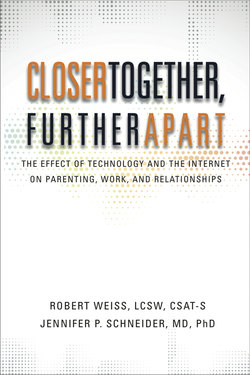Читать книгу Closer Together, Further Apart: The Effect of Technology and the Internet on Parenting, Work, and Relationships - Jennifer Schneider - Страница 8
На сайте Литреса книга снята с продажи.
What the Scholars and Philosophers Have to Say
ОглавлениеOver the last 150 years, sociologists and anthropologists have created various theories on social and cultural evolution. Among these noted scholars is Lewis H. Morgan, a contemporary of Charles Darwin, who identified technological progress as the driving factor in the development of human civilization. Morgan divided humanity into three major stages—savagery, barbarism, and civilization—relying on technological milestones to separate one from the next. In the savage era we had fire, the bow and arrow, and pottery; in the barbarian era we developed agriculture, metalworking, and domesticated animals; in the civilized era we invented the alphabet.4 In other words, for about 730 lifetimes humans were savages and barbarians, and then we learned to write.
Gerhard Lenski, a later philosopher, stated that the more information a society has, the more advanced it is. He viewed human development as occurring in four stages based on advances in the art/science of communication.
| Lenski’s Four Stages of Human Development | |
| Stage One | Generational information was passed on via genetic material. |
| Stage Two | Humans gained the ability to perceive and develop wisdom, learning through experience and by watching the actions of others. |
| Stage Three | Humans developed logic and started using signs (or pictographs) to represent their experiences. (Example: cave drawings) |
| Stage Four | Humans developed language, abstract symbols, and writing. |
Lenski’s basic theory is that advances in the technology of communication translate into advances in the economic system, the political system, and virtually every other sphere of human existence.5
Both Morgan and Lenski identified the final sociological/anthropological leap based on the ability of human beings to communicate beyond the face-to-face, to interact without having to physically occupy the same space. And, as Toffler eloquently explains in Future Shock, that ability has been with us in a meaningful way for only a very brief period, really only picking up steam in the last two hundred years or so as the printed word became slowly but steadily more accessible.
